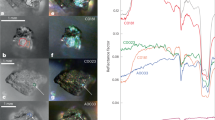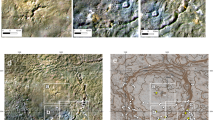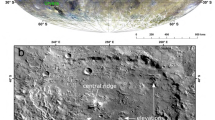Abstract
The dwarf planet Ceres is the largest object in the asteroid belt, and is generally thought to be a differentiated body composed primarily of silicate materials and water ice1,2. Some remotely observed features, however, indicate that Ceres may instead have a composition more similar to that of the most common types of carbonaceous meteorite3,4,5,6,7. In particular, Ceres has been shown to have a distinct infrared absorption feature centred at a wavelength of ∼3.06 μm that is superimposed on a broader absorption from ∼2.8 to 3.7 μm (refs 5, 8), which suggests the presence of OH- or H2O-bearing phases. The specific mineral composition of Ceres and its relationship to known meteorite mineral assemblages, however, remains uncertain. Here we show that the spectral features of Ceres can be attributed to the presence of the hydroxide brucite, magnesium carbonates and serpentines, a mineralogy consistent with the aqueous alteration of olivine-rich materials. We therefore suggest that the thermal and aqueous alteration history of Ceres is different from that recorded by carbonaceous meteorites, and that samples from Ceres are not represented in existing meteorite collections.
This is a preview of subscription content, access via your institution
Access options
Subscribe to this journal
Receive 12 print issues and online access
$259.00 per year
only $21.58 per issue
Buy this article
- Purchase on Springer Link
- Instant access to full article PDF
Prices may be subject to local taxes which are calculated during checkout



Similar content being viewed by others
References
McCord, T. & Sotin, C. Ceres: Evolution and current state. J. Geophys. Res. 110, E05009 (2005).
Thomas, P.C. et al. Differentiation of the asteroid Ceres as revealed by its shape. Nature 437, 224–226 (2005).
Johnson, T. V. & Fanale, F. Optical properties of carbonaceous chondrites and their relationship to asteroids. J. Geophys. Res. 75, 8507–8518 (1973).
McCord, T. & Gaffey, M. J. Asteroids: Surface composition from reflectance spectroscopy. Science 186, 352–355 (1974).
Lebofsky, L. A. Asteroid 1 Ceres: Evidence for water of hydration. Mon. Not. R. Astron. Soc. 182, 17–21 (1978).
Feierberg, M., Lebofsky, L. & Larson, H. Spectroscopic evidence for aqueous alteration products on the surfaces of low-albedo asteroids. Geochim. Cosmo. Acta 45, 971–981 (1981).
Rivkin, A., Volquardsen, E. & Clark, B. The surface composition of Ceres: Discovery of carbonates and iron-rich clays. Icarus 185, 563–567 (2007).
Jones, T., Lebofsky, L., Lewis, J. & Marley, M. The composition and origin of the C, P, and D asteroids: Water as a tracer of thermal evolution in the outer belt. Icarus 88, 172–192 (1990).
Gaffey, M., Burbine, T. & Binzel, R. Asteroid spectroscopy: Progress and perspectives. Meteoritics 28, 161–187 (1993).
Lebofsky, L, Feierberg, M., Tokunaga, A., Larson, H. & Johnson, J. The 1.7–4.2 μm spectrum of asteroid 1 Ceres: Evidence for structural water in clay minerals. Icarus 48, 453–459 (1981).
Fanale, F. P. & Salvail, J. R. The water regime of asteroid 1 Ceres. Icarus 82, 97–110 (1989).
King, T., Clark, R., Calvin, W., Sherman, D. & Brown, R. Evidence for ammonium-bearing minerals on Ceres. Science 255, 1551–1553 (1992).
Müller, W., Kurat, G. & Kracher, A. Chemical and crystallographic study of cronstedtite in the matrix of the Cochabamba (CM2) carbonaceous chondrite. Mineral. Petrol. 26, 293–304 (1979).
Mackinnon, I. & Buseck, P. New phyllosilicate types in a carbonaceous chondrite matrix. Nature 280, 219–220 (1979).
Barber, D. Matrix phyllosilicates and associated minerals in C2M carbonaceous chondrites. Geochim. Cosmo. Acta 45, 945–970 (1981).
Mara, R. T. & Sutherland, G. The infrared spectrum of brucite. J. Opt. Soc. Am. 43, 1100–1102 (1953).
Tomeoka, K. & Buseck, P. Indicators of aqueous alteration in CM carbonaceous chondrites: Microtextures of a layered mineral containing Fe, S, O and Ni. Geochim. Cosmo. Acta 49, 2149–2163 (1985).
Mackinnon, I. & Zolensky, M. Proposed structures for poorly characterized phases in C2M carbonaceous chondrite meteorites. Nature 309, 240–242 (1984).
Moroz, L. V., Kozerenko, S. & Fadeev, V. The Reflectance Spectrum of Synthetic Tochilinite. 28th Lunar and Planetary Science Conf. 1288, LPI, Houston, TX (1997).
Mara, R. T. The Infrared Spectrum of Crystalline Brucite (Mg(OH) 2). Thesis, Univ. Michigan (1954).
Frost, R. & Kloprogge, J. Infrared emission spectroscopic study of brucite. Spectro. Acta 55, 2195–2205 (1999).
Cohen, M., Witteborn, F., Roush, T., Bregman, J. & Wooden, D. Spectral irradiance calibration in the infrared. VIII. 5–14 μm spectroscopy of the asteroids Ceres, Vesta, and Pallas. Astron. J. 115, 1671–1679 (1998).
Milliken, R. E. & Mustard, J. Estimating the water content of hydrated minerals using reflectance spectroscopy I. Effects of darkening agents and low-albedo materials. Icarus 189, 550–573 (2007).
Britt, D. & Pieters, C. Darkening in black and gas-rich ordinary chondrites: The spectral effects of opaque morphology and distribution. Geochim. Cosmo. Acta 58, 3905–3919 (1994).
Clark, R. M. Spectral properties of mixtures of montmorillonite and dark carbon grains: Implications for remote sensing minerals containing chemically and physically adsorbed water. J. Geophys. Res. 88, 10635–10644 (1983).
Grimm, R. E. & McSween, H. Water and the thermal evolution of carbonaceous chondrite parent bodies. Icarus 82, 244 (1989).
Nesbitt, H. W. & Bricker, O. Low temperature alteration processes affecting ultramafic bodies. Geochim. Cosmo. Acta 42, 403–409 (1978).
Peng, Y. et al. An experimental study on the hydrothermal preparation of tochilinite nanotubes and tochilinite-serpentine-intergrowth nanotubes from metal particulates. Geochim. Cosmo. Acta 71, 2858–2875 (2007).
Benedix, G., Leshin, L., Farquhar, J., Jackson, T. & Thiemens, M. Carbonates in CM2 chondrites: Constraints on alteration conditions from oxygen isotopic compositions and petrographic observations. Geochim. Cosmo. Acta 67, 1577–1588 (2003).
Rayman, M., Fraschetti, T., Raymond, C. & Russell, C. Dawn: A mission in development for exploration of main belt asteroids Vesta and Ceres. Acta Astronaut. 58, 605–616 (2006).
Acknowledgements
This research was carried out at the Jet Propulsion Laboratory, California Institute of Technology, under a contract with NASA. We also acknowledge support from RELAB at Brown University, the NASA Planetary Astronomy Program and the Infrared Telescope Facility, which is operated by the University of Hawaii under Cooperative Agreement no. NCC 5-538 with the NASA Planetary Astronomy Program.
Author information
Authors and Affiliations
Contributions
R.E.M. was responsible for writing most of the text and the spectral modelling. A.S.R. contributed to the text, acquired and provided the near-infrared spectrum of Ceres and assisted with interpretation of the results.
Corresponding author
Supplementary information
Supplementary Information
Supplementary Information (PDF 358 kb)
Rights and permissions
About this article
Cite this article
Milliken, R., Rivkin, A. Brucite and carbonate assemblages from altered olivine-rich materials on Ceres. Nature Geosci 2, 258–261 (2009). https://doi.org/10.1038/ngeo478
Received:
Accepted:
Published:
Issue Date:
DOI: https://doi.org/10.1038/ngeo478
This article is cited by
-
Late accretion of Ceres-like asteroids and their implantation into the outer main belt
Nature Astronomy (2023)
-
Atmospheric carbon depletion as a tracer of water oceans and biomass on temperate terrestrial exoplanets
Nature Astronomy (2023)
-
Relict Ocean Worlds: Ceres
Space Science Reviews (2020)
-
True polar wander of Ceres due to heterogeneous crustal density
Nature Geoscience (2018)
-
High-temperature water–rock interactions and hydrothermal environments in the chondrite-like core of Enceladus
Nature Communications (2015)



